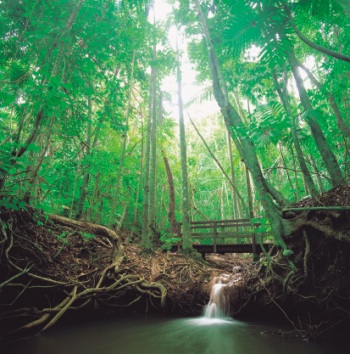Introduction
For an overview of the structure and make-up of a rainforest visit The Rainforest by clicking on the picture below and complete the activity before continuing on to the following information.
Rainforests are very important to the global ecosystem. They:
- provide a home to many plants and animals;
- help stabilize the world’s climate;
- protect against flood, drought, and erosion;
- are a source of medicines and foods; and
- are an interesting place to visit.
(Mongabay, 2010)
Rainforests have a very interesting and unique structure. There are many different layers, each playing an important role as they support different plant and animal species. The different layers are shown in the diagram below:

There are two types of rainforests found near the equator – Temperate and Tropical – but what is the difference?
Temperate Rainforests:
- Are cooler.
- Are found along the coasts in the temperate zones.
- There are fewer temperate forests in the world, and they cover less area.
Tropical Rainforests:
- Are warmer.
- Are found closer to the equator, most of which are in an area between the Tropic of Cancer and the Tropic of Capricorn.
- Can be found in South and Central America, Africa, Australia, and Asia.
- They cover only about 6% of the Earth’s surface.
(Save The Rainforest, 2011)
To read more on the difference between Temperate and Tropical rainforests visit this website and follow the side tool bar through to “Types of Rainforests”.
Rainforests are also key environments as they support a wide variety of animals and plants.


